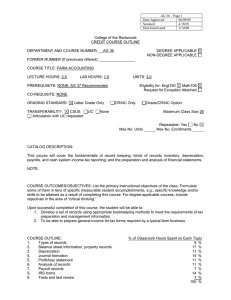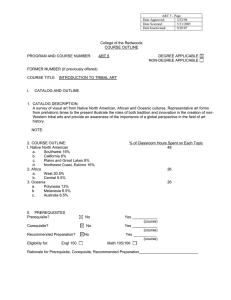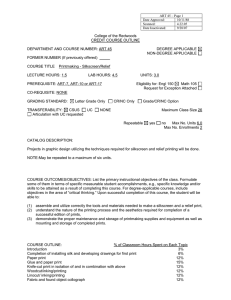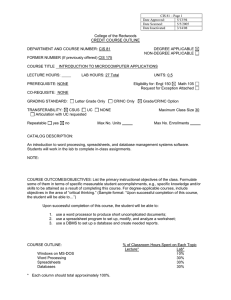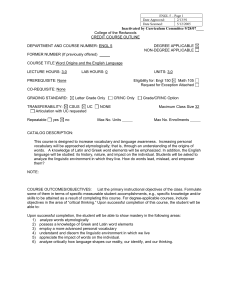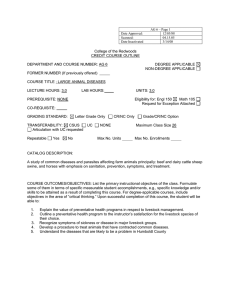Inactivated by Curriculum Committee 9/14/07__ College of the Redwoods CREDIT COURSE OUTLINE
advertisement
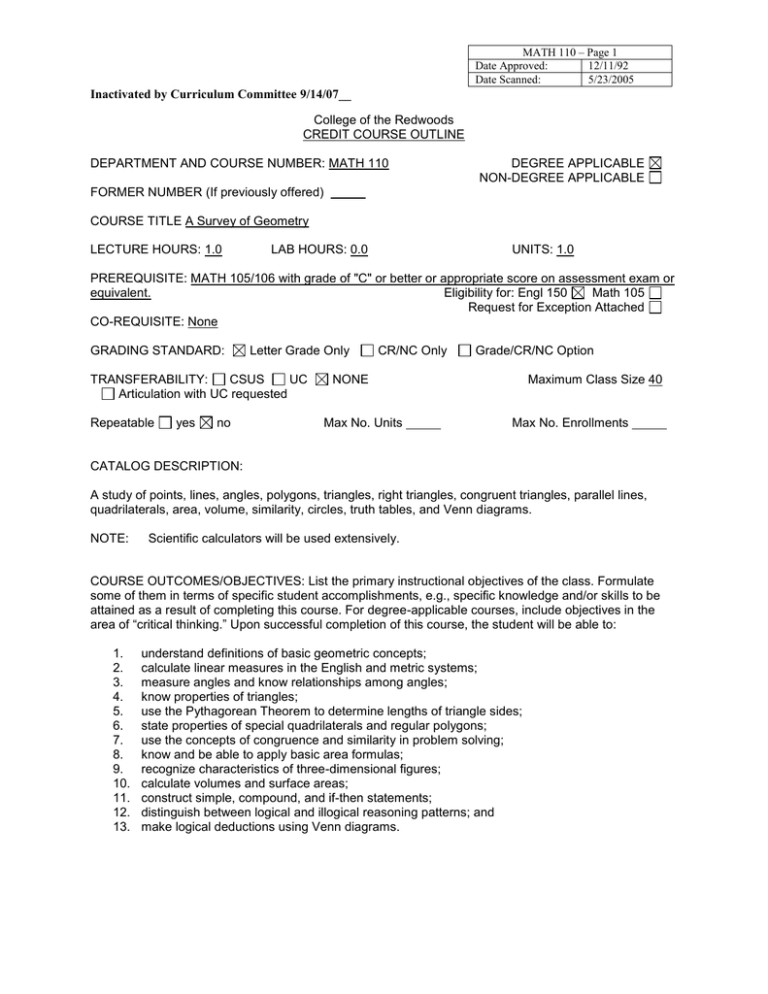
MATH 110 – Page 1 Date Approved: 12/11/92 Date Scanned: 5/23/2005 Inactivated by Curriculum Committee 9/14/07__ College of the Redwoods CREDIT COURSE OUTLINE DEPARTMENT AND COURSE NUMBER: MATH 110 DEGREE APPLICABLE NON-DEGREE APPLICABLE FORMER NUMBER (If previously offered) COURSE TITLE A Survey of Geometry LECTURE HOURS: 1.0 LAB HOURS: 0.0 UNITS: 1.0 PREREQUISITE: MATH 105/106 with grade of "C" or better or appropriate score on assessment exam or equivalent. Eligibility for: Engl 150 Math 105 Request for Exception Attached CO-REQUISITE: None GRADING STANDARD: Letter Grade Only TRANSFERABILITY: CSUS UC Articulation with UC requested Repeatable yes no CR/NC Only Grade/CR/NC Option NONE Max No. Units Maximum Class Size 40 Max No. Enrollments CATALOG DESCRIPTION: A study of points, lines, angles, polygons, triangles, right triangles, congruent triangles, parallel lines, quadrilaterals, area, volume, similarity, circles, truth tables, and Venn diagrams. NOTE: Scientific calculators will be used extensively. COURSE OUTCOMES/OBJECTIVES: List the primary instructional objectives of the class. Formulate some of them in terms of specific student accomplishments, e.g., specific knowledge and/or skills to be attained as a result of completing this course. For degree-applicable courses, include objectives in the area of “critical thinking.” Upon successful completion of this course, the student will be able to: 1. 2. 3. 4. 5. 6. 7. 8. 9. 10. 11. 12. 13. understand definitions of basic geometric concepts; calculate linear measures in the English and metric systems; measure angles and know relationships among angles; know properties of triangles; use the Pythagorean Theorem to determine lengths of triangle sides; state properties of special quadrilaterals and regular polygons; use the concepts of congruence and similarity in problem solving; know and be able to apply basic area formulas; recognize characteristics of three-dimensional figures; calculate volumes and surface areas; construct simple, compound, and if-then statements; distinguish between logical and illogical reasoning patterns; and make logical deductions using Venn diagrams. MATH 110 – Page 2 Date Approved: 12/11/92 Date Scanned: 5/23/2005 Inactivated by Curriculum Committee 9/14/07__ COURSE OUTLINE: Basic geometric concepts Linear measurement Angle measurement Triangles and the Pythagorean Theorem Special quadrilaterals and regular polygons Congruence and similarity Basic area formulas Areas of compound figures Three-dimensional figures Volume Simple and compound statements Statements of negation If-then statements Reasoning patterns Venn diagrams % of Classroom Hours Spent on Each Topic 8 6 6 8 8 8 6 6 6 6 8 6 6 6 6 APPROPRIATE TEXTS AND MATERIALS: (Indicate textbooks that may be required or recommended, including alternate texts that may be used.) Text(s) Title: Geometry and Logic Concepts Required Edition: 1st ISBN 0-534-92235-X Alternate Author: Kaufmann Recommended Publisher: PWS-Kent Date Published: 1989 (Additional required, alternate, or recommended texts should be listed on a separate sheet and attached.) For degree applicable courses the adopted texts have been certified to be college-level: Yes. Basis for determination: is used by two or more four-year colleges or universities (certified by the Division Chair or Branch Coordinator, or Center Dean) OR has been certified by the LAC as being of college level using the Coleman and Dale-Chall Readability Index Scale. No. Request for Exception Attached If no text or a below college level text is used in a degree applicable course, a request for exception must be attached and a rationale provided. This request for exception will be approved or denied by the Curriculum Committee. MATH 110 – Page 3 Date Approved: 12/11/92 Date Scanned: 5/23/2005 Inactivated by Curriculum Committee 9/14/07__ METHODS TO MEASURE STUDENT ACHIEVEMENT: Please check where appropriate; however, a degree applicable course must have a minimum of one response in category 1, 2, or 3. If category 1 is not checked, the department must explain why substantial writing assignments are an inappropriate basis for at least part of the grade. 1. Substantial writing assignments, including: essay exam(s) term or other paper(s) written homework reading report(s) laboratory report(s) other (specify) _____ If the course is degree applicable, substantial writing assignments in this course are inappropriate because: The course is primarily computational in nature. The course primarily involves skill demonstrations or problem solving. Other rationale (explain) __________________________________________ 2. Computational or Non-computational problem-solving demonstrations, including: exam(s) quizzes homework problems laboratory report(s) field work other (specify)_______ 3. Skill demonstrations, including: class performance(s) other (specify)____ 4. Objective examinations, including: multiple choice completion field work performance exam(s) true/false matching items other (specify) problem solving NOTE: A course grade may not be based solely on attendance. REQUIRED READING, WRITING, AND OTHER OUTSIDE OF CLASS ASSIGNMENTS: Over an 18-week presentation of the course, 3 hours per week are required for each unit of credit. ALL Degree Applicable Credit classes must treat subject matter with a scope and intensity which require the student to study outside of class. Two hours of independent work done out of class are required for each hour of lecture. Lab and activity classes must also require some outside of class work. Outside of the regular class time the students in this class will be doing the following: Study Answer questions Skill practice Required reading Problem solving activity or exercise Written work (essays/compositions/report/analysis/research) Journal (reaction and evaluation of class, done on a continuing basis throughout the semester) Observation of or participation in an activity related to course content (e.g., play, museum, concert, debate, meeting, etc.) Field trips Other (specify) ____________________________ NOTE: ALL Degree Applicable Credit classes must treat subject matter with a scope and intensity which require the student to study outside of class. Therefore, activity classes for which degree credit status is requested must also indicate, on the above list, the areas of outside study. MATH 110 – Page 4 Date Approved: 12/11/92 Date Scanned: 5/23/2005 Inactivated by Curriculum Committee 9/14/07__ COLLEGE LEVEL CRITICAL THINKING TASKS/ASSIGNMENTS: Degree applicable courses must include critical thinking tasks/assignments. This section need not be completed for non-degree applicable courses. Describe how the course requires students to independently analyze, synthesize, explain, assess, anticipate and/or define problems, formulate and assess solutions, apply principles to new situations, etc. Students will determine which geometric properties are appropriate to use in specific situations. Students will apply theorems to various applied geometric problems. Students will identify and classify geometric properties.
